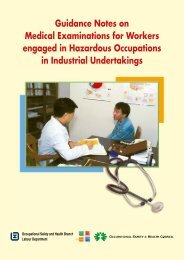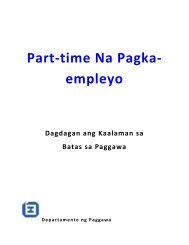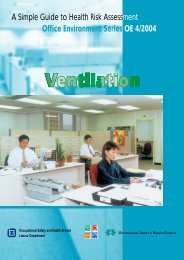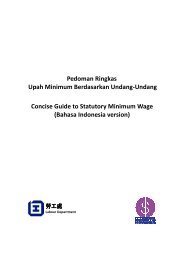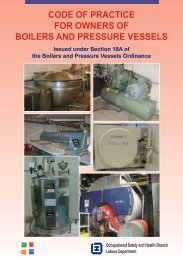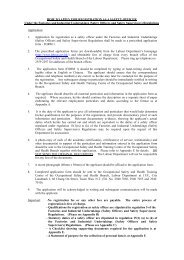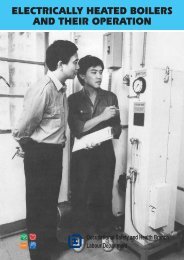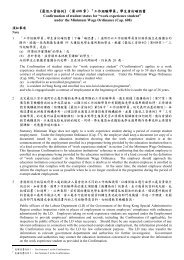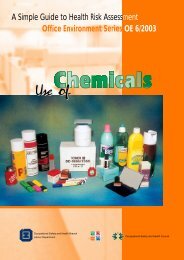Safety at Work for Maintenance if Low Voltage Electrical Switchgears
Safety at Work for Maintenance if Low Voltage Electrical Switchgears
Safety at Work for Maintenance if Low Voltage Electrical Switchgears
You also want an ePaper? Increase the reach of your titles
YUMPU automatically turns print PDFs into web optimized ePapers that Google loves.
This Guidance Notes is prepared by<br />
the Occup<strong>at</strong>ional <strong>Safety</strong> and Health Branch,<br />
Labour Department<br />
This edition<br />
July 2004<br />
This Guidance Notes is issued free of charge and can be obtained from<br />
offices of the Occup<strong>at</strong>ional <strong>Safety</strong> and Health Branch, Labour Department.<br />
It can also be downloaded from website of the Labour Department <strong>at</strong><br />
http://www.labour.gov.hk/eng/public/os/C/B145.pdf. Addresses and telephone<br />
numbers of the offices can be found on the website of the Department <strong>at</strong><br />
http://www.labour.gov.hk/eng/tele/osh.htm or by telephone 2559 2297.<br />
This Guidance Notes may be freely reproduced except <strong>for</strong> advertising,<br />
endorsement or commercial purposes. Please acknowledge the source<br />
as "Guidance Notes on <strong>Safety</strong> <strong>at</strong> <strong>Work</strong> <strong>for</strong> <strong>Maintenance</strong> of <strong>Low</strong> <strong>Voltage</strong><br />
<strong>Electrical</strong> <strong>Switchgears</strong>", published by the Labour Department.
Table of Contents<br />
1. Introduction 2<br />
2. Duties of Proprietors and <strong>Work</strong>ers 4<br />
3. Hazards and Risk Assessment 6<br />
4. General <strong>Safety</strong> Issues 9<br />
5. <strong>Safety</strong> Be<strong>for</strong>e <strong>Work</strong> 14<br />
6. <strong>Safety</strong> During <strong>Work</strong> 15<br />
7. <strong>Safety</strong> After Completion of <strong>Work</strong> 16<br />
8. Emergency Preparedness 17<br />
1<br />
<strong>Safety</strong> <strong>at</strong> <strong>Work</strong> <strong>for</strong> <strong>Maintenance</strong> of <strong>Low</strong> <strong>Voltage</strong> <strong>Electrical</strong> <strong>Switchgears</strong><br />
9. In<strong>for</strong>m<strong>at</strong>ion, Instruction and Training 18<br />
Useful in<strong>for</strong>m<strong>at</strong>ion 21
1. Introduction<br />
1.1 Proper maintenance of low voltage electrical switchgears<br />
("electrical switchgear") is essential in preventing the equipment<br />
failures th<strong>at</strong> cause interruption of power supply to customers and<br />
users. However the maintenance work itself, <strong>if</strong> not done properly<br />
and in a safe manner, may lead to accidents causing serious bodily<br />
injuries or even de<strong>at</strong>hs to the workers.<br />
1.2 Without implementing and following a safe system of work,<br />
workers engaged in electrical switchgear maintenance work are<br />
vulnerable to various safety and health hazards.<br />
2<br />
<strong>Safety</strong> <strong>at</strong> <strong>Work</strong> <strong>for</strong> <strong>Maintenance</strong> of <strong>Low</strong> <strong>Voltage</strong> <strong>Electrical</strong> <strong>Switchgears</strong><br />
1.3 This Guidance Notes is intended to provide general practical<br />
guidance to electrical contractors, electrical workers, supervisors<br />
and other workers engaged in electrical switchgear maintenance<br />
work to carry out the work in a safe and healthy manner.<br />
Proprietors should note th<strong>at</strong> the work task, working environment<br />
and working constraints etc. may vary from time to time. They<br />
should there<strong>for</strong>e make use of this Guidance Notes to develop their<br />
own safe systems of work th<strong>at</strong> best suits the spec<strong>if</strong>ic work tasks<br />
and work conditions.<br />
1.4 Readers' <strong>at</strong>tention is also drawn to the relevant legisl<strong>at</strong>ive<br />
requirements under the provisions of the Occup<strong>at</strong>ional <strong>Safety</strong> and<br />
Health Ordinance (Cap. 509) and Factories and Industrial<br />
Undertakings Ordinance (Cap. 59) and their subsidiary<br />
regul<strong>at</strong>ions, in particular the Factories and Industrial Undertakings<br />
(Electricity) Regul<strong>at</strong>ions (Cap. 59W), administr<strong>at</strong>ed by the Labour<br />
Department. Readers should also pay <strong>at</strong>tention to the requirements<br />
of the Electricity Ordinance (Cap. 406) and the subsidiary<br />
regul<strong>at</strong>ions administr<strong>at</strong>ed by and the Code of Practice <strong>for</strong> the<br />
Electricity (Wiring) Regul<strong>at</strong>ions issued by the <strong>Electrical</strong> and<br />
Mechanical Services Department.<br />
1.5 This Guidance Notes covers the maintenance work of low voltage<br />
electrical switchgears. For high voltage install<strong>at</strong>ions, it involves<br />
much more stringent safety requirements due to the higher<br />
oper<strong>at</strong>ing voltage of the install<strong>at</strong>ions and will not be covered in<br />
this Guidance Notes.
Remark:<br />
"extra low voltage" (# !"<br />
– means any voltage not exceeding 50 volts altern<strong>at</strong>ing current or<br />
120 volts direct current whether between conductors or to earth.<br />
"high voltage" (i !<br />
– means any voltage normally exceeding low voltage.<br />
"low voltage" ({ !<br />
– means any voltage normally exceeding extra low voltage but not<br />
exceeding 1000 volts altern<strong>at</strong>ing current or 1500 volts direct<br />
current between conductors or 600 volts altern<strong>at</strong>ing current or 900<br />
volts direct current between conductors and earth.<br />
3<br />
<strong>Safety</strong> <strong>at</strong> <strong>Work</strong> <strong>for</strong> <strong>Maintenance</strong> of <strong>Low</strong> <strong>Voltage</strong> <strong>Electrical</strong> <strong>Switchgears</strong>
2. Duties of Proprietors and <strong>Work</strong>ers<br />
Overview<br />
2.1<br />
Securing the safety and health <strong>at</strong> work <strong>for</strong> the electrical switchgear<br />
maintenance work requires the full commitment and co-oper<strong>at</strong>ion<br />
of everyone concerned, from the proprietors to the workers.<br />
Duties of proprietor<br />
4<br />
<strong>Safety</strong> <strong>at</strong> <strong>Work</strong> <strong>for</strong> <strong>Maintenance</strong> of <strong>Low</strong> <strong>Voltage</strong> <strong>Electrical</strong> <strong>Switchgears</strong><br />
2.2 It is the duty of every proprietor to ensure, so far as is reasonably<br />
practicable, the safety and health <strong>at</strong> work of all workers. The<br />
proprietor, including contractor should demonstr<strong>at</strong>e the<br />
commitment in managing safety and health and bear the final<br />
responsibility and accountability <strong>for</strong> the safety and health in the<br />
workplace.<br />
2.3 The duties of a proprietor include, but not limited to, the<br />
following:<br />
(a) to manage safety and health in the workplace, and to provide<br />
the necessary resources;<br />
(b) to ensure th<strong>at</strong> the responsibilities <strong>for</strong> managing safety and<br />
health are appropri<strong>at</strong>ely assigned, and the duties are effectively<br />
carried out by the staff concerned;<br />
(c) to assess the risk <strong>at</strong> work, and to establish appropri<strong>at</strong>e safety<br />
measures <strong>for</strong> the work;<br />
(d) to provide suitable and safe plant and equipment <strong>for</strong> the work,<br />
and to ensure th<strong>at</strong> the plant and equipment are regularly<br />
checked and properly maintained;<br />
(e) to establish safety rules and safe working procedures <strong>for</strong> the<br />
work;<br />
(f) to provide necessary in<strong>for</strong>m<strong>at</strong>ion, instructions and training to<br />
the workers and to ensure th<strong>at</strong> they follow the safety rules<br />
and safe working procedures <strong>at</strong> work strictly;<br />
(g) to ensure th<strong>at</strong> only electrical contractors registered under the<br />
Electricity Ordinance (Cap. 406) are appointed to carry out<br />
any electrical work;
(h) to ensure th<strong>at</strong> only workers who are qual<strong>if</strong>ied and, by reason<br />
of their knowledge, training and practical experience,<br />
competent, e.g. registered electrical workers, are selected to<br />
carry out electrical work. In assessing the qual<strong>if</strong>ic<strong>at</strong>ion and<br />
competence of a worker, reference should be made to the<br />
legisl<strong>at</strong>ive requirement under the Electricity Ordinance (Cap.<br />
406); and<br />
(i) to establish emergency response plans and conduct drills<br />
regularly.<br />
2.4 The proprietor often employs management personnel such as<br />
managers, engineers, safety personnel, <strong>for</strong>emen or supervisors to<br />
act on his behalf <strong>for</strong> managing safety and health in the workplace.<br />
The management personnel should effectively discharge their<br />
supervisory and management duties to ensure the safety and health<br />
<strong>at</strong> work of the workers. In this regard, the authority and<br />
responsibility of each management personnel should be precisely<br />
set out and made known to all persons concerned.<br />
Duties of <strong>Work</strong>ers<br />
2.5 <strong>Work</strong>ers are required to take reasonable care <strong>for</strong> the safety and<br />
health of themselves and of others who may be affected by their<br />
acts or omissions <strong>at</strong> work. They are also required to co-oper<strong>at</strong>e<br />
with their proprietors or the management personnel so far as is<br />
necessary to enable them to comply with the legal duties imposed<br />
on them.<br />
2.6 The duties of a worker include, but not limited to, the following:<br />
(a) to understand and act in accordance with the safety rules, safe<br />
working procedures and emergency response plan;<br />
5<br />
<strong>Safety</strong> <strong>at</strong> <strong>Work</strong> <strong>for</strong> <strong>Maintenance</strong> of <strong>Low</strong> <strong>Voltage</strong> <strong>Electrical</strong> <strong>Switchgears</strong><br />
(b) to make full use of the safety equipment and personal<br />
protective equipment provided, and to report any equipment<br />
defect to the management/ supervisor immedi<strong>at</strong>ely;<br />
(c) to provide feedback to the management/supervisor on the<br />
effectiveness of safety measures, safe working procedures and<br />
emergency response plans; and<br />
(d) to report to the management/ supervisor all hazards observed,<br />
defects ident<strong>if</strong>ied or accidents incurred <strong>at</strong> work.
3. Hazards and Risk Assessment<br />
The hazards<br />
3.1<br />
The hazards in electrical switchgear maintenance work can be<br />
broadly grouped into the following major c<strong>at</strong>egories:<br />
(a) <strong>Electrical</strong> shock hazards;<br />
(b) Fire and explosion hazards; and<br />
(c) Other rel<strong>at</strong>ed hazards.<br />
3.2 <strong>Electrical</strong> shock hazards:<br />
6<br />
<strong>Safety</strong> <strong>at</strong> <strong>Work</strong> <strong>for</strong> <strong>Maintenance</strong> of <strong>Low</strong> <strong>Voltage</strong> <strong>Electrical</strong> <strong>Switchgears</strong><br />
(a) The workers are vulnerable to electric shock hazard whilst<br />
working on the conductive parts of the electrical switchgear<br />
which has not been properly isol<strong>at</strong>ed from the power source.<br />
Electric shock hazard also arises from the improper applic<strong>at</strong>ion<br />
of high voltage test on the electrical switchgear.<br />
(b) Electric shock can cause serious injury or even de<strong>at</strong>h to the<br />
worker due to cardiac arrest, respir<strong>at</strong>ory arrest or body burn.<br />
3.3 Fire and explosion hazards:<br />
(a) Fire and explosion in electrical switchgear maintenance work<br />
can be caused by accidental short-circuit of live parts and<br />
earthed parts by, say, metal hand tools, substandard testing<br />
equipment, loosen parts detached or <strong>for</strong>eign objects left inside<br />
the switchgear after work.<br />
(b) Fire and explosion of the switchgear can cause serious injury<br />
or even de<strong>at</strong>h to the workers due to severe body burn caused<br />
by the hot gas mass or molten metal, inhal<strong>at</strong>ion of smoke<br />
caused by the fire or eye injury caused by the intensive light<br />
and ultra-violet radi<strong>at</strong>ion gener<strong>at</strong>ed by electric arcing.<br />
3.4 Other rel<strong>at</strong>ed hazards:<br />
There are other hazards th<strong>at</strong> rel<strong>at</strong>e to electrical switchgear<br />
maintenance work. These include, but not limited to, the following:<br />
(a) hazards rel<strong>at</strong>ed to the falling from height of workers when<br />
working on electrical switchgear installed <strong>at</strong> high levels;
(b) tripping hazards due to tangling of electric wires of portable<br />
tools or loose hand tools placed on the floor; and<br />
(c) musculoskeletal problems resulting from manual handling of<br />
heavy objects such as air circuit breakers or prolonged periods<br />
of awkward postures.<br />
Risk assessment<br />
3.5 Risk assessment in electrical switchgear maintenance work is an<br />
evalu<strong>at</strong>ion process to assess the likelihood of causing harms by<br />
the hazards mentioned in Sections 3.1 to 3.4 and the severity of<br />
those harms. This provides the necessary in<strong>for</strong>m<strong>at</strong>ion <strong>for</strong><br />
establishing the appropri<strong>at</strong>e safety measures, safe working<br />
procedures and emergency response procedures be<strong>for</strong>e<br />
commencing the maintenance work. The scale and depth of the<br />
risk assessment depend on the working environment and the<br />
complexity of the work.<br />
3.6 The basic steps in risk assessment include the following:<br />
(a) to ident<strong>if</strong>y the hazards;<br />
(b) to consider who may be affected and how;<br />
(c) to evalu<strong>at</strong>e the risks arising from the hazards, and to consider<br />
whether the existing safety measures are adequ<strong>at</strong>e or more<br />
should be done;<br />
(d) to record the findings; and<br />
(e) to review the assessment from time to time and to revise <strong>if</strong><br />
necessary.<br />
3.7 Risk assessment should be spec<strong>if</strong>ic to the required task. Factors<br />
to be considered in assessing risks associ<strong>at</strong>ed with electrical<br />
switchgear maintenance work include, but not limited to, the<br />
following:<br />
7<br />
<strong>Safety</strong> <strong>at</strong> <strong>Work</strong> <strong>for</strong> <strong>Maintenance</strong> of <strong>Low</strong> <strong>Voltage</strong> <strong>Electrical</strong> <strong>Switchgears</strong><br />
(a) the type of electrical switchgear to work on;<br />
(b) the type of work to be carried out;<br />
(c) whether the electrical switchgear to work on is isol<strong>at</strong>ed,<br />
energised or partially energised;
(d) the working environment, including<br />
(i) whether access to and egress from the workplace are safe,<br />
suitable and adequ<strong>at</strong>e;<br />
(ii) whether lighting and ventil<strong>at</strong>ion of the workplace are<br />
sufficient and suitable;<br />
(iii) whether the workplace is congested or restrictive;<br />
(iv) whether working <strong>at</strong> height is necessary;<br />
(v) whether there are combustible/flammable m<strong>at</strong>erials<br />
nearby;<br />
(vi) whether the workplace is hot, damp, dusty or the<br />
environment is corrosive, etc; and<br />
8<br />
<strong>Safety</strong> <strong>at</strong> <strong>Work</strong> <strong>for</strong> <strong>Maintenance</strong> of <strong>Low</strong> <strong>Voltage</strong> <strong>Electrical</strong> <strong>Switchgears</strong><br />
(e) The strength of the working team and the competence of team<br />
members.<br />
3.8 The risk assessment should be conducted by a competent person<br />
with the appropri<strong>at</strong>e knowledge, experience and relevant training<br />
to enable him to assess the risks arising from the work. The person<br />
should have good understanding of the work as well as good<br />
knowledge of the safe practices and safety measures required.<br />
3.9 Risk assessment should be reviewed regularly. Whenever there<br />
has been a sign<strong>if</strong>icant change in the working conditions, working<br />
environment or the particulars of the work, risk assessment should<br />
be re-conducted.
4. General <strong>Safety</strong> Issues<br />
4.1 Failure to suitably and adequ<strong>at</strong>ely plan <strong>for</strong> the work ahead is the<br />
cause of many electrical accidents. Adequ<strong>at</strong>e in<strong>for</strong>m<strong>at</strong>ion,<br />
including manufacturer's manuals and diagrams about the<br />
electrical switchgear, should be made available to facilit<strong>at</strong>e the<br />
planning and development of a safe system of work <strong>for</strong> the<br />
electrical switchgear maintenance work.<br />
4.2 The system of work should include a set of safety rules and<br />
procedures commensur<strong>at</strong>e with the type of electrical switchgears<br />
to work on and the maintenance work to be carried out. The safety<br />
rules or procedures may also incorpor<strong>at</strong>e a 'permit-to-work'<br />
system. The established safety rules or procedures should be made<br />
available to all workers engaged in the maintenance work. It has<br />
also to ensure th<strong>at</strong> they do understand and follow the rules and<br />
procedures <strong>at</strong> work.<br />
4.3 The appropri<strong>at</strong>e engineering controls and administr<strong>at</strong>ive controls<br />
should be taken to ensure th<strong>at</strong> the work is safe and without risk to<br />
health. Any electricity sources, including the mains power supply,<br />
temporary power supply and backup power supply, <strong>if</strong> any, should<br />
be fully isol<strong>at</strong>ed be<strong>for</strong>e the commencement and during the course<br />
of work.<br />
4.4 The workers and their supervisors, the building management and<br />
the users should be well in<strong>for</strong>med ahead of any scheduled<br />
interruption of power supply to facilit<strong>at</strong>e the maintenance work.<br />
4.5 Accidents usually happen when workers are in a hurry. There<strong>for</strong>e,<br />
not-withstanding th<strong>at</strong> there is usually a pressing need to resume<br />
power supply to the users, do allow sufficient time <strong>for</strong> the workers<br />
to carry out the maintenance work. When compared with in-house<br />
staff, external contractor and workers should be allowed more time<br />
<strong>for</strong> the work as they are less familiar with the working environment<br />
and the switchgear to work on.<br />
9<br />
<strong>Safety</strong> <strong>at</strong> <strong>Work</strong> <strong>for</strong> <strong>Maintenance</strong> of <strong>Low</strong> <strong>Voltage</strong> <strong>Electrical</strong> <strong>Switchgears</strong><br />
4.6 It has to ensure th<strong>at</strong> the workers are always physically fit <strong>for</strong> the<br />
work. One may become tired and hard to concentr<strong>at</strong>e when working<br />
overnight or after a prolonged period of work. Breaks should be<br />
allowed <strong>for</strong> the workers to take sufficient rests.
4.7 It may be required to carry out pre-inspection/checking <strong>at</strong> site in<br />
the planning of work. Th<strong>at</strong> is particularly important <strong>for</strong> old<br />
install<strong>at</strong>ions where diagrams, drawings and manuals of the<br />
install<strong>at</strong>ions may not be available.<br />
4.8 Only workers who have received proper training and have the<br />
relevant knowledge, experience and understand the safety rules and<br />
procedures should be assigned to carry out the maintenance work.<br />
It has to ensure th<strong>at</strong> all workers always comply with the safety rules<br />
or procedures strictly <strong>at</strong> work.<br />
10<br />
<strong>Safety</strong> <strong>at</strong> <strong>Work</strong> <strong>for</strong> <strong>Maintenance</strong> of <strong>Low</strong> <strong>Voltage</strong> <strong>Electrical</strong> <strong>Switchgears</strong><br />
4.9 The workers should be supplied with tools, m<strong>at</strong>erials and<br />
equipment suitable <strong>for</strong> the work, and other necessary in<strong>for</strong>m<strong>at</strong>ion<br />
as laid down in the safety rules and procedures. Suitable safety<br />
equipment such as insul<strong>at</strong>ed tools, insul<strong>at</strong>ion m<strong>at</strong>s, insul<strong>at</strong>ion<br />
stands etc., should be provided and used in exceptional situ<strong>at</strong>ion<br />
where not the whole switchgear/switchboard is isol<strong>at</strong>ed <strong>for</strong> work.<br />
4.10 Sufficient working space should be allowed. Furthermore access<br />
ways should be properly maintained and kept free from<br />
obstructions.<br />
4.11 There should be effective communic<strong>at</strong>ion amongst the workers<br />
and clear order of command <strong>at</strong> work to prevent accidents. The<br />
supervisor should carry out regular checks on the work to ensure<br />
th<strong>at</strong> the workers adhere to the laid-down safety rules or<br />
procedures. If non-registered electrical workers are employed,<br />
they should be continuously under the direct and close supervision<br />
of registered electrical workers and the supervisor.<br />
4.12 Good housekeeping in the workplace is important in preventing<br />
accidents. Loose m<strong>at</strong>erials or tools should be placed in boxes or<br />
proper containers instead of leaving on the floor freely.<br />
4.13 The workplace should always be dry and clean. The switchroom<br />
and meter room should not be used as a storeroom.<br />
4.14 Adequ<strong>at</strong>e and suitable lighting should be provided and maintained<br />
<strong>for</strong> illumin<strong>at</strong>ion of the workplace and the equipment to work on.<br />
4.15 Suitable and adequ<strong>at</strong>e ventil<strong>at</strong>ion of the workplace should also<br />
be provided and maintained.
4.16 The temporary power supply provided <strong>for</strong> lighting and the work<br />
should be proper and safe. If diesel gener<strong>at</strong>or is used to provide<br />
temporary electricity supply <strong>for</strong> the workplace, the gener<strong>at</strong>or<br />
should be placed in a well-ventil<strong>at</strong>ed place where the engine<br />
exhaust gas could be properly dispersed. The power extension<br />
cables should be properly placed to avoid damage or tripping<br />
hazard. The power socket circuit should be completed with a<br />
residual current device of 30 mA tripping current.<br />
4.17 Suitable and adequ<strong>at</strong>e fire extinguishers should be made available.<br />
It should be noted th<strong>at</strong> w<strong>at</strong>er type fire extinguisher is not suitable<br />
<strong>for</strong> an electric fire. Carbon dioxide or dry power type fire<br />
extinguisher should be used instead.<br />
4.18 Cleaning is a common task in the maintenance of electrical<br />
switchgear/switchboard. Non-flammable and non-toxic solvents<br />
and m<strong>at</strong>erials should be chosen <strong>for</strong> the work. Otherwise, suitable<br />
and adequ<strong>at</strong>e precautions, including the provision and use of<br />
suitable personal protective equipment, against fire and toxic<br />
effects caused by the solvents/m<strong>at</strong>erials should be taken.<br />
4.19 Where practicable, work on low voltage electrical switchgear<br />
should be carried out only after the electrical switchgear has been<br />
properly isol<strong>at</strong>ed, locked out and ver<strong>if</strong>ied dead by suitable testing<br />
equipment or voltage indic<strong>at</strong>or. Be<strong>for</strong>e using the testing equipment<br />
and voltage indic<strong>at</strong>or, they should be checked first to ver<strong>if</strong>y th<strong>at</strong><br />
they oper<strong>at</strong>e properly.<br />
4.20 For main electrical switchboards, it should be noted th<strong>at</strong> switching<br />
off the main switch or the main circuit breaker could isol<strong>at</strong>e only<br />
the load side of switch, e.g. the main busbar and the downstream<br />
circuits, whereas the source side of switch is still energised. The<br />
workers would be vulnerable to electric shock hazard when they<br />
work on or in the vicinity of the source side of the main switch.<br />
In th<strong>at</strong> respect, one should as far as reasonably practicable, make<br />
prior arrangement with the power company to isol<strong>at</strong>e the mains<br />
power supply connected to the main switchboard so as to render<br />
dead the whole switchboard including the source side of the main<br />
switch. It is not warranted to omit this step just <strong>for</strong> saving of time<br />
or convenience.<br />
11<br />
<strong>Safety</strong> <strong>at</strong> <strong>Work</strong> <strong>for</strong> <strong>Maintenance</strong> of <strong>Low</strong> <strong>Voltage</strong> <strong>Electrical</strong> <strong>Switchgears</strong>
4.21 Control fuses should be removed too to isol<strong>at</strong>e also the control<br />
circuit of the electrical switchgear/switchboard.<br />
4.22 For some electrical install<strong>at</strong>ions, there are emergency gener<strong>at</strong>ors<br />
or uninterrupted power supply system (UPS) used as backup power<br />
supply source. One has also to safely isol<strong>at</strong>e and lock off those<br />
gener<strong>at</strong>ors and UPS to render the electrical switchgear dead be<strong>for</strong>e<br />
working on it.<br />
4.23 Where serious inconvenience would arise from isol<strong>at</strong>ing circuits,<br />
adequ<strong>at</strong>e precautions should be taken to avoid danger from work<br />
involving the handling of energised parts or working within<br />
touchable distance, direct or indirect, of energised parts <strong>at</strong> low<br />
voltage. The following precautions are to be taken:<br />
12<br />
<strong>Safety</strong> <strong>at</strong> <strong>Work</strong> <strong>for</strong> <strong>Maintenance</strong> of <strong>Low</strong> <strong>Voltage</strong> <strong>Electrical</strong> <strong>Switchgears</strong><br />
(a) work on energised low voltage equipment should be done only<br />
by registered electrical workers, or in their presence, who has<br />
been authorized by the responsible person <strong>for</strong> such work;<br />
(b) screen or other means to avoid danger from inadvertent contact<br />
with energised conductors should be provided; and<br />
(c) fixing warning notices <strong>for</strong> repair, barriers and screens.<br />
4.24 Where danger cannot be avoided <strong>for</strong> working on energised<br />
equipment the electrical equipment should be isol<strong>at</strong>ed and ver<strong>if</strong>ied<br />
dead with a suitable testing equipment or voltage indic<strong>at</strong>or; a<br />
permit-to-work should be issued.<br />
4.25 Where work is to be done on dead low voltage electrical equipment<br />
controlled by a circuit breaker or switch, the circuit breaker or<br />
switch should be locked off where practicable and a warning notice<br />
<strong>for</strong> repair affixed. The keys <strong>for</strong> locks used to lock off circuit<br />
breaker or switch should be kept under the control of a responsible<br />
person.<br />
4.26 In case there is any unavoidable live work, it should minimize<br />
the dur<strong>at</strong>ion and extension of the live work to minimize the risk<br />
the workers exposed to. Once the unavoidable live work is<br />
finished, the involved electric circuit should be isol<strong>at</strong>ed and<br />
ver<strong>if</strong>ied dead and with the power supply locked out be<strong>for</strong>e<br />
proceeding with the remaining work.
4.27<br />
A permit-to-work system should be adopted in situ<strong>at</strong>ions where<br />
the risk <strong>at</strong> work is to be properly controlled. Typical situ<strong>at</strong>ions<br />
include, but not limited to, the following:<br />
(a) the n<strong>at</strong>ure of work is complic<strong>at</strong>ed;<br />
(b) the scope of work is wide; or<br />
(c) there are energised parts in the switchgear/switchboard when<br />
the work is carried out.<br />
13<br />
<strong>Safety</strong> <strong>at</strong> <strong>Work</strong> <strong>for</strong> <strong>Maintenance</strong> of <strong>Low</strong> <strong>Voltage</strong> <strong>Electrical</strong> <strong>Switchgears</strong>
5. <strong>Safety</strong> Be<strong>for</strong>e <strong>Work</strong><br />
5.1 Prior to the commencement of work, an on-site briefing should<br />
be provided to all the workers so th<strong>at</strong> everyone understands the<br />
overall scope of work to be done, the works programme, job duties<br />
of the individuals, special points to note, the safety rules or<br />
procedures, etc. Preferably there should be a briefing <strong>for</strong>m<br />
containing all the items briefed and it should be signed by all<br />
workers <strong>at</strong>tended the briefing session.<br />
5.2 Be<strong>for</strong>e start working, it should check th<strong>at</strong> the working environment<br />
is safe, e.g. the ingress/egress p<strong>at</strong>hs are clear, lighting and<br />
ventil<strong>at</strong>ion are in order, fire fighting appliances are available, etc.<br />
14<br />
<strong>Safety</strong> <strong>at</strong> <strong>Work</strong> <strong>for</strong> <strong>Maintenance</strong> of <strong>Low</strong> <strong>Voltage</strong> <strong>Electrical</strong> <strong>Switchgears</strong><br />
5.3 When the work starts, the electrical switchgear to work on should<br />
first be isol<strong>at</strong>ed and proved dead according to the laid-down safety<br />
rules or procedures. The relevant switch/isol<strong>at</strong>or should also be<br />
locked out, or <strong>if</strong> it is unlockable, be properly fenced off, so th<strong>at</strong><br />
the power supply will not be restored inadvertently. A suitable<br />
warning notice should also be <strong>at</strong>tached to or placed close to the<br />
switch/isol<strong>at</strong>or.<br />
5.4 Be<strong>for</strong>e working on the conductive parts of an electrical switchgear/<br />
switchboard, one has also to safely discharge any possible<br />
electrical energy stored in the install<strong>at</strong>ion, e.g. th<strong>at</strong> from the power<br />
factor correction capacitor banks.<br />
5.5 In exceptional situ<strong>at</strong>ion th<strong>at</strong> the work has to be done on a partly<br />
live electrical switchboard and the workers are liable to work not<br />
far away from the exposed live parts, then suitable and adequ<strong>at</strong>e<br />
safety precautions, e.g. keeping a safe clear distance from the live<br />
parts, erecting physical barriers around the live parts and posting<br />
of warning notices, etc. should be taken to prevent inadvertent<br />
contact with the live parts. Those live parts should be well<br />
ident<strong>if</strong>ied. Also a permit-to-work system should be adopted.
6. <strong>Safety</strong> During <strong>Work</strong><br />
6.1 It is important to prevent unauthorized personnel from encroaching<br />
on the area of work, in particular when the electrical install<strong>at</strong>ion<br />
is live or testing on the electrical install<strong>at</strong>ion is on-going.<br />
6.2 It is not uncommon th<strong>at</strong> during the course of work, part of the<br />
switchgear/switchboard would be re-energised <strong>for</strong> testing or a<br />
voltage/current be applied to the switchgear/switchboard <strong>for</strong><br />
testing. It is important th<strong>at</strong> all workers should be in<strong>for</strong>med of the<br />
test and kept off from the switchgear/switchboard during the test.<br />
6.3 If the switchgear/switchboard has been re-energised <strong>for</strong> testing,<br />
then after the completion of the tests and be<strong>for</strong>e proceeding to<br />
further work on the install<strong>at</strong>ion, it is important to isol<strong>at</strong>e the<br />
install<strong>at</strong>ion and ver<strong>if</strong>y it is dead again using suitable testing<br />
equipment or voltage indic<strong>at</strong>or be<strong>for</strong>e allowing the workers to<br />
continue with the work.<br />
6.4 If it is unavoidable to work on or near a live electrical install<strong>at</strong>ion,<br />
in addition to the other safety precautions to be taken as described<br />
in this Guidance Notes, workers should also use protective<br />
equipment, such as insul<strong>at</strong>ed gloves, insul<strong>at</strong>ed m<strong>at</strong>s, insul<strong>at</strong>ed<br />
screens, insul<strong>at</strong>ed clothing etc., of the suitable type and grade <strong>for</strong><br />
the work. Hand tools <strong>for</strong> work such as spanner, screwdriver etc.,<br />
should also be of the insul<strong>at</strong>ed type.<br />
15<br />
<strong>Safety</strong> <strong>at</strong> <strong>Work</strong> <strong>for</strong> <strong>Maintenance</strong> of <strong>Low</strong> <strong>Voltage</strong> <strong>Electrical</strong> <strong>Switchgears</strong>
7. <strong>Safety</strong> After Completion of <strong>Work</strong><br />
7.1 Upon the completion of work and be<strong>for</strong>e re-energising the<br />
electrical switchgear/switchboard and putting them back to<br />
service, it has to ensure th<strong>at</strong>:<br />
(a) the equipment, meters, devices, etc. of the switchgear/<br />
switchboard are restored to correct working conditions and<br />
settings;<br />
(b) all tools, equipment and m<strong>at</strong>erials <strong>for</strong> work have been removed<br />
from the electrical switchgear/switchboard;<br />
(c) all parts of the switchgear have been tightened and there are<br />
no loosened parts;<br />
16<br />
<strong>Safety</strong> <strong>at</strong> <strong>Work</strong> <strong>for</strong> <strong>Maintenance</strong> of <strong>Low</strong> <strong>Voltage</strong> <strong>Electrical</strong> <strong>Switchgears</strong><br />
(d) all covers, panels and doors of the switchgear/switchboard are<br />
replaced properly and locked tight;<br />
(e) except the one who carries out the switching work, all persons<br />
should keep clear of the switchgear/switchboard be<strong>for</strong>e it is<br />
re-energised. It is desirable to have only minimal number of<br />
workers staying in the switchroom during switching of the<br />
switchgear/switchboard; and<br />
(f) no person except the work-in-charge should order <strong>for</strong><br />
switching on the switchgear/switchboard and only the<br />
design<strong>at</strong>ed competent person should carry out the switching<br />
oper<strong>at</strong>ion.<br />
7.2 In case tools or m<strong>at</strong>erials are found missing after the switchgear/<br />
switchboard are energised, do not try to re-open the switchgear<br />
doors/panels straight away to look <strong>for</strong> the missing tools/m<strong>at</strong>erials.<br />
Report the incident to the supervisor immedi<strong>at</strong>ely to arrange <strong>for</strong><br />
shutting down of power supply to the switchgear/switchboard.
8. Emergency Preparedness<br />
8.1 Emergency response procedures should be established <strong>for</strong> the<br />
workers and other staff to follow in case of emergency. The<br />
procedures should include guidance <strong>for</strong> the workers th<strong>at</strong> explains<br />
when and how they should react and include the evacu<strong>at</strong>ion from<br />
the workplace in extreme situ<strong>at</strong>ions.<br />
8.2 The loc<strong>at</strong>ion of emergency exits and evacu<strong>at</strong>ion p<strong>at</strong>hs in case of<br />
emergency should be made known to all members of the working<br />
team. Those exits and evacu<strong>at</strong>ion p<strong>at</strong>hs should always be kept clear<br />
and well lit. Any exit door should be unlocked.<br />
8.3 Suitable fire extinguishing appliances should be made available<br />
<strong>at</strong> the workplace. The workers should be trained on the use of<br />
such appliances.<br />
8.4 Adequ<strong>at</strong>e devices, e.g. telephone, should be made available <strong>for</strong><br />
calling the emergency services in the workplace or its vicinity.<br />
The workers should be provided with such devices or be in<strong>for</strong>med<br />
of where to get such devices quickly.<br />
8.5 <strong>Work</strong>ers should be well in<strong>for</strong>med of and trained in the safe<br />
procedures to follow to isol<strong>at</strong>e the power supply to the workplace,<br />
both permanent and temporary, in case of emergency.<br />
8.6 It is preferred <strong>for</strong>, <strong>at</strong> least some, members of the working team be<br />
given training in first aid and cardio-pulmonary resuscit<strong>at</strong>ion<br />
(CPR) to give timely tre<strong>at</strong>ment to victims in the un<strong>for</strong>tun<strong>at</strong>e event<br />
of electric shock or explosion.<br />
17<br />
<strong>Safety</strong> <strong>at</strong> <strong>Work</strong> <strong>for</strong> <strong>Maintenance</strong> of <strong>Low</strong> <strong>Voltage</strong> <strong>Electrical</strong> <strong>Switchgears</strong>
9. In<strong>for</strong>m<strong>at</strong>ion, Instruction and Training<br />
Overview<br />
9.1<br />
The proprietor should ensure th<strong>at</strong> the workers, including electrical<br />
workers of appropri<strong>at</strong>e grade registered with the <strong>Electrical</strong> &<br />
Mechanical Services Department and others, undertaking electrical<br />
switchgear maintenance work should possess, by virtue of relevant<br />
training and experience, the competence th<strong>at</strong> commensur<strong>at</strong>e with<br />
the assigned task. The training and experience should cover not<br />
only the techniques of electrical switchgear maintenance work but<br />
also the selection and safe use of proper equipment as well as the<br />
safety and health aspects of the work.<br />
18<br />
<strong>Safety</strong> <strong>at</strong> <strong>Work</strong> <strong>for</strong> <strong>Maintenance</strong> of <strong>Low</strong> <strong>Voltage</strong> <strong>Electrical</strong> <strong>Switchgears</strong><br />
9.2 The safety and health training should include general induction<br />
and more spec<strong>if</strong>ic training, and may be met by a mixture of<br />
on-the-job and off-the-job training, and should involve<br />
demonstr<strong>at</strong>ions and practical exercises. It should embrace good<br />
trade practices, constituents of a safe workplace and in<strong>for</strong>m<strong>at</strong>ion<br />
on the particular working conditions.<br />
9.3 Notwithstanding th<strong>at</strong> the workers have been trained in the general<br />
safety and health aspects of electrical switchgear maintenance<br />
work, the proprietor should provide appropri<strong>at</strong>e in<strong>for</strong>m<strong>at</strong>ion,<br />
instruction and training to the workers on the safety and health<br />
aspects spec<strong>if</strong>ic to the assigned task.<br />
9.4 The in<strong>for</strong>m<strong>at</strong>ion, instruction and training should appropri<strong>at</strong>ely<br />
cover, but not limited to, the following:<br />
(a) safety and health rules established in the workplace;<br />
(b) safe working procedures <strong>for</strong> the assigned task;<br />
(c) proper selection and use of equipment and m<strong>at</strong>erials;<br />
(d) proper selection, proper use and limit<strong>at</strong>ions of personal<br />
protective equipment;<br />
(e) emergency response procedures and evacu<strong>at</strong>ion plan; and
(f) spec<strong>if</strong>ic safety and health consider<strong>at</strong>ion, such as working on<br />
isol<strong>at</strong>ed circuit or under energised conditions, working within<br />
touchable distance of energised parts, working <strong>at</strong> height,<br />
manual handling of large workpieces, use of solvents, etc.<br />
9.5 When there are sign<strong>if</strong>icant changes in the working environment,<br />
the proprietor should review the new situ<strong>at</strong>ion and provide<br />
sufficient in<strong>for</strong>m<strong>at</strong>ion, instruction and appropri<strong>at</strong>e training to<br />
workers to per<strong>for</strong>m the task in the new environment in a safe and<br />
healthy manner.<br />
General safety and health training<br />
9.6 All persons involved in the electrical switchgear maintenance work<br />
should be fully trained in the safety and health aspects of the work<br />
under normal oper<strong>at</strong>ion as well as in emergencies. The general<br />
safety and health training should cover:<br />
(a) hazards in electrical switchgear maintenance work;<br />
(b) relevant legisl<strong>at</strong>ion and responsibilities of the persons<br />
concerned;<br />
(c) equipment and safety devices <strong>for</strong> the work, including their uses<br />
and limit<strong>at</strong>ions;<br />
(d) safety measures, including the selection and use of safety<br />
equipment and personal protective equipment, and their<br />
limit<strong>at</strong>ions;<br />
(e) general safe practices <strong>for</strong> the work;<br />
(f) emergency response and procedures including evacu<strong>at</strong>ion plan;<br />
(g) general examin<strong>at</strong>ion and maintenance of equipment, pre-use<br />
and after-use equipment checks; and<br />
19<br />
<strong>Safety</strong> <strong>at</strong> <strong>Work</strong> <strong>for</strong> <strong>Maintenance</strong> of <strong>Low</strong> <strong>Voltage</strong> <strong>Electrical</strong> <strong>Switchgears</strong><br />
(h) build up good co-ordin<strong>at</strong>ion with other workers and the<br />
awareness of taking care of other persons during their course<br />
of work.
Task-spec<strong>if</strong>ic safety and health training<br />
9.7 In addition to the general safety and health training in electrical<br />
switchgear maintenance work, task-spec<strong>if</strong>ic training should be<br />
provided to the workers <strong>for</strong> each and every electrical switchgear<br />
maintenance work. This is particularly important <strong>if</strong> the workers<br />
are to carry out the maintenance work <strong>at</strong> workplaces they are not<br />
familiar with. The training is to enable the workers to:<br />
(a) understand clearly th<strong>at</strong> particular work task, the work<br />
programme and the safe systems of work in place;<br />
(b) understand and ident<strong>if</strong>y all potential hazards in the working<br />
environment and the necessary precautions to be taken; and<br />
20<br />
(c) ident<strong>if</strong>y factors affecting their individual capabilities in the<br />
work, and etc.<br />
<strong>Safety</strong> <strong>at</strong> <strong>Work</strong> <strong>for</strong> <strong>Maintenance</strong> of <strong>Low</strong> <strong>Voltage</strong> <strong>Electrical</strong> <strong>Switchgears</strong>
Useful In<strong>for</strong>m<strong>at</strong>ion<br />
If you wish to enquire about this guidance notes or require advice on<br />
occup<strong>at</strong>ional safety and health, please contact the Occup<strong>at</strong>ional <strong>Safety</strong><br />
and Health Branch of the Labour Department through:<br />
Telephone : 2559 2297 (auto-recording after office hours)<br />
Fax : 2915 1410<br />
E-mail : enquiry@labour.gov.hk<br />
In<strong>for</strong>m<strong>at</strong>ion on the services offered by the Labour Department and on<br />
major labour legisl<strong>at</strong>ion can also be found by visiting our Home Page in<br />
the Internet. Address of our Home Page is http://www.labour.gov.hk.<br />
In<strong>for</strong>m<strong>at</strong>ion on the services offered by the Occup<strong>at</strong>ional <strong>Safety</strong> and<br />
Health Council can also be obtained through hotline 2739 9000.<br />
21<br />
<strong>Safety</strong> <strong>at</strong> <strong>Work</strong> <strong>for</strong> <strong>Maintenance</strong> of <strong>Low</strong> <strong>Voltage</strong> <strong>Electrical</strong> <strong>Switchgears</strong>



